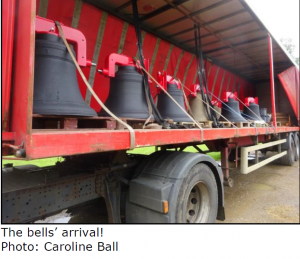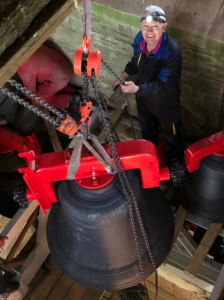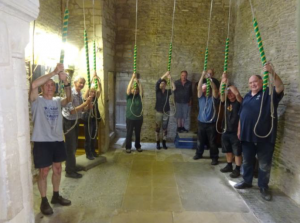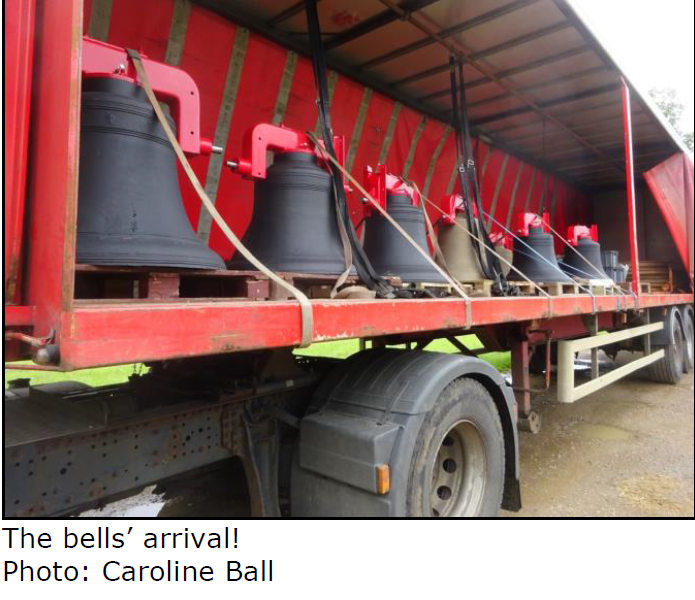The church of St Peter and St Paul at Broadwell, Oxfordshire, is a picturesque 12th-14th century Grade I listed church nestled off the beaten track just beyond Clanfield and Black Bourton. Historically a ring of 5, with bells ranging from the 14th to the 17th century, the bells have almost certainly been unringable for more than 100 years following an unsuccessful refurbishment of the bell frame by Bond of Burford.
The current project of restoration was conceived in 2014 following a Quinquennial review which indicated remedial work was needed to the bell frame within 12 months and to the bells within 5 years. The initial plan was to simply make the bells ringable, with a possible augmentation to a ring of 6, but soon the project expanded to become an augmentation to 8, when Tony Crabtree was consulted!
The lighter trebles would offer better teaching opportunities and easier combinations for the emerging local band. After a detailed bell survey it became evident that the work needed would be much more extensive than originally envisaged. The original belfry was in the spire and after the Bond refurbishment it is reputed that the spire shook when the bells were rung.
Scary, so the firm plan became to reposition the belfry down a level into the old clock-room/ringing chamber and to have a ground floor ring with the bell ringers invading the rather large vestry. All good in theory. After a bidding process Nicholsons of Bridport were awarded the bell work.
The project was delayed by a series of problems to be overcome, logistics, cracked bells and of course the awful Coronavirus. Of the original bells, the original no 2, cast in c1349, was retired and repurposed as a chiming bell rehung alone in the old belfry. Two new bells were commissioned, the new treble dedicated to Madeleine Goñi and the no 5 dedicated to Frederick Roger Goodenough and two bells were donated by the Keltek Trust from Yorktown, Camberley which were successfully retuned, including substantial work at the soundbows, as the nos 2 and 3.
Of the original bells, the tenor, a rather large c16cwt (now 15-2-12) cast in about 1500 by Thomas Hasylwood was a problem throughout (of which more later) but came back as the no 8 along with the no 7 cast in 1581 by Joseph Carter, the no 6 cast in 1653 and the old treble, now no 4 cast in 1663
I came to the party late in July 2020 when Tony Crabtree asked if I could help. By that stage work was just about to commence on the masonry in the clock-room to accommodate the brand-new bell-frame. The walls of the church were soft so it was relatively easy to remove, the problem was it was too easy as the ancient stone crumbled away revealing rubble fill behind the skin. We were worried about the effect of the stability of the tower so stopped work almost as soon as we had started to get in an expert stone mason to check and advise on stabilising the interior.
This was successful, thank goodness. At that stage the bells were due back before the end of 2020, already a year behind schedule, but that was not to be, largely due to the restrictions and staff shortages caused by Coronavirus. The old belfry needed a lot of work cleaning and removing the old rotten, unsafe floor. Not an easy job when you could only safely work from the various beams of the structure requiring a degree of agility and nerves of steel. It was after this the work stopped again until 2021.
It was with some excitement that I returned to Broadwell at the beginning of July 2021. The bells, which I’d not actually seen thus far, were returning/arriving – quite a spectacular sight when the lorry sides were lifted to reveal them. Of course, this was the start of some heavy work.

The local farmer kindly lent a tractor and farm worker to move them, first off the lorry then around to the church. It was fascinating watching Ian Hasman, the bell hanger, positioning them as they came off the lorry. Anyone who’s been involved with a rehang will know that nothing is done without a reason, and the bells were placed in not a random order, but the order they needed to go into the church and up into the tower. A short service was held to dedicate the new bells and bless the rest, with the tenor arriving to start the service for all to wonder at its huge size.
Post service the job of getting the tenor back into the church commenced with full audience. It had to go in at an angle because it was wider than the door and whilst getting it out the team had discovered what they believed to be old marks on the ancient church walls which they believed came from the time the tenor first arrived. Well, the tenor made its presence felt and demonstrated very well that it was not easy to get a big bell through a narrow door.
The temporary wooden floor to get over the steps cracked and the wall saved the bell from damaging a pew. This slowed down considerably its return into the church but the willing team of volunteers led by the unflappable Ian Hasman moved the tenor inside inch by inch.
It was with some excitement for all that the bells were systematically winched into place, like a giant 3-D jigsaw puzzle and not everything fitted in nicely first time. The tenor being the most problematic. After several days of careful fitting and finessing all 8 were in place and we hoped were ringable. This meant on 16 July 2021 the bells were finally tested.

There were a few issues, the tenor had a snagging clapper which had to come off and be adjusted and the no 5 had a problem with its bearing too. It was rather charming to receive a message from the other side of the village post ringing for the first time, ‘the bells sound lovely, but could you ring them louder?’!

The bells had their first proper outing on 21 July 2021 when they were rung, minus the 5, for a wedding and all eight sounded magnificent three weeks later for another wedding.
A project like this cannot be completed without a significant amount of volunteer help, thanks go to all the helpers.
By Caroline Ball

No responses yet